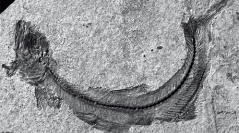

 Geodiversitas
35 (2) - Pages 345-357
Geodiversitas
35 (2) - Pages 345-357The study of a newly collected fossil material has given the opportunity for describing the anatomy of the species Enoplophthalmus schlumbergeri Sauvage, 1880, an osmerid from the Early Oligocene of the Apt-Céreste-Forcalquier syncline (Vaucluse, Alpes-de-Haute-Provence, France). Our study has shown that this species is directly related to the extant species Mallotus villosus (Müller, 1776), which is mainly living in the northern parts of the Atlantic and Pacific oceans and in the glacial Arctic Ocean. Like it, it exhibits a sexual dimorphism concerning the anal fin. Its coexistence with Dapalis macrurus (Agassiz, 1836), a species of fossil fishes which is related to the recent chandids of the Indo-Australian area, reinforces the “seasonal equability” theory, according to which the climates were less strictly defined during Eocene and Oligocene times than they are presently.
Osmeridae, Enoplophthalmus, Oligocene, Provence, South France, sexual dimorphism, palaeoclimatological significance